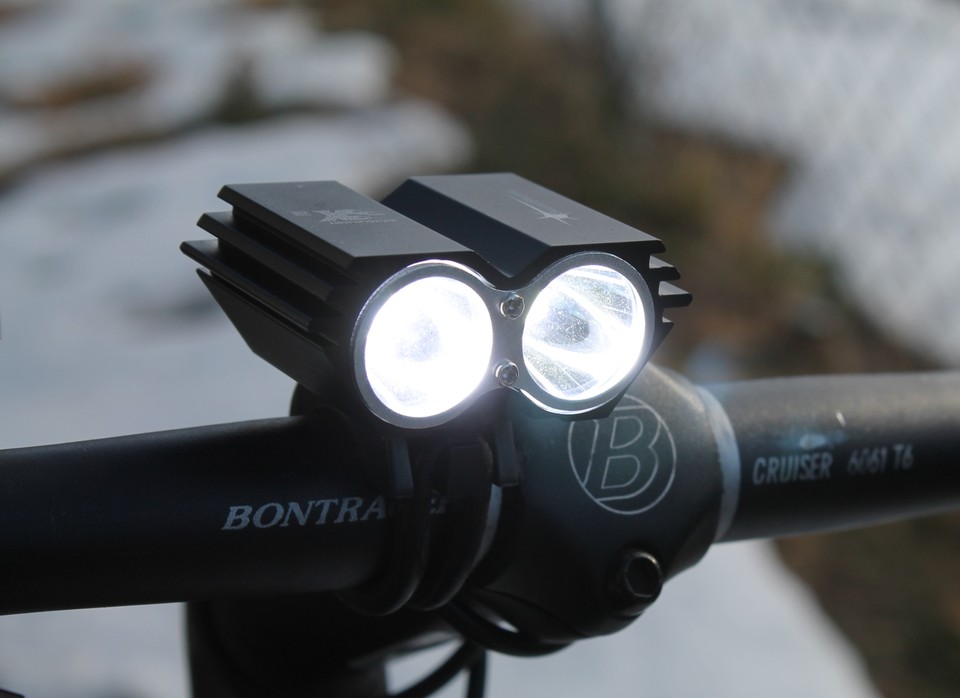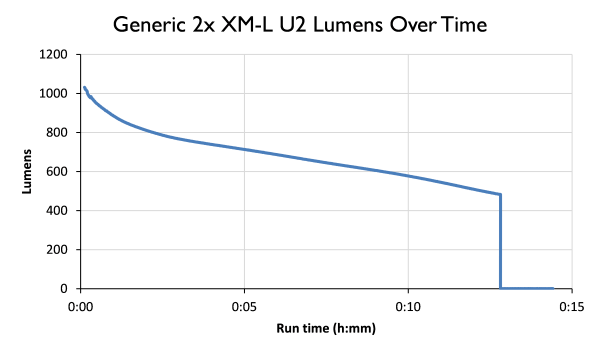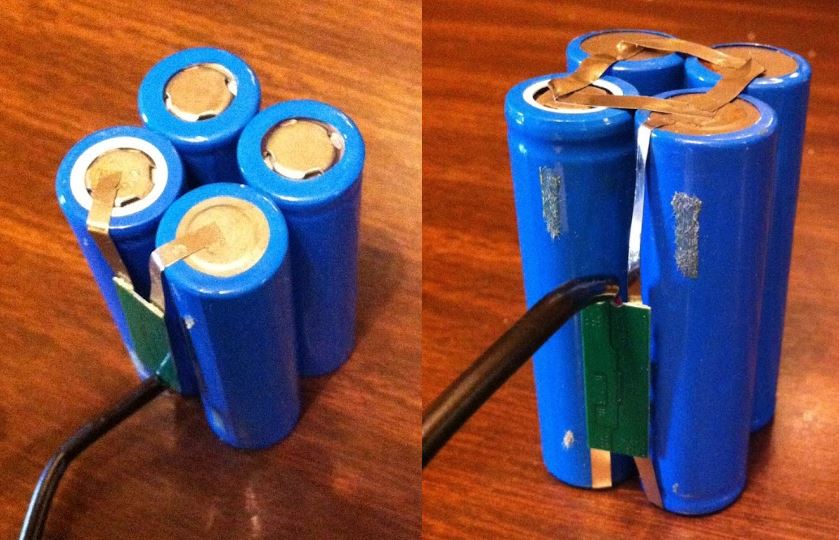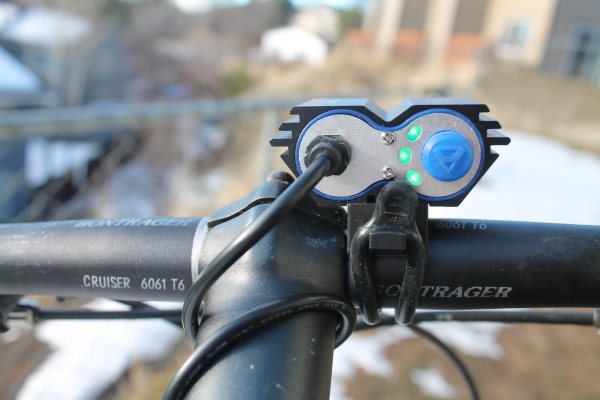
- 5000 claimed lumens
- 950 measured lumens
- 3h 00min reported battery life
- 12min measured battery life
-
 Made in CN
Made in CN
- 486 g
- flashing mode
- no pulse mode
- 3 brightness levels
- Included mounts: Strap
Dozens of vendors sell rebranded versions of this light on eBay, Amazon, and elsewhere. The lighthead is nearly identical on all variations, consisting of two Cree XM-L2 U2 LEDs and a single mode selection/power button. The battery pack varies significantly from supplier to supplier and even within products from a single vendor. Other names for this light include "SolarStorm X2" and "SecurityIng". Vendors claim anywhere from 2000 to 5000 lumens output, though actual output is about 1000 lumens on the highest setting.
Review: With false promises and poor quality, you get what you pay for
Review by Nathan Hinkle, May 4, 2015, 6 a.m. . Updated Aug. 24, 2015.
It's difficult to review this light because there are so many different variations. I purchased the unit I reviewed on Amazon from a vendor which no longer even exists, but dozens of others have popped up to take its place. And that is the very issue with these lights: you never quite know what you're getting. They all look the same, are all made by generic manufacturers in cheap Chinese factories, and none of them have a reputable company backing up the product. You could order 10 of these lights from 10 different vendors and get different performance, build quality, and longevity – and there's no way to tell how good a particular light will be until it shows up.
Updated August 2015 with information about battery safety. NOTE: This product may be dangerous! For safety reasons we do not recommend purchasing generic lights from unreliable manufacturers.
About those 5000 lumens...

Let's start with the most absurd claim attached to these lights. You'll see these lights advertised as producing anywhere from 1800 to 5000 lumens. Using Cree's output estimator, the max output from two XM-L U2 LEDs is 1700 lumens.[1] Anything claiming more than 1700 lumens is a blatant lie, but even this is only a theoretical maximum at the highest possible current draw. Few lights actually reach the maximum output, as it would draw 20W just for the LEDs alone.[2] Even without accounting for the power consumption of the circuit board and other components, this would drain a standard 4x 18650 battery pack built with quality batteries in under 2 hours, and many of these lights are sold with recycled low-capacity batteries which drain much faster.
The reality is that unless you measure for yourself, it's impossible to tell what the actual lumens output of these lights will be. It's never as high as the marketing claims, but the true value depends on many factors which can't be accounted for in the estimation tools. I went ahead and measured one of these lights myself using an integrating sphere – the scientific instrument used to accurately and reliably measure the actual lumens of a device. The results? After 30 seconds, the output was measured at 950 lumens. By the time 2 minutes had passed, it was down to 810.
Of course, 800 lumens is without a doubt sufficient for almost any type of ride, even on dark forest trails. And there's no question that these lights pack a powerful punch relative to their cost. However, buyer beware, the marketing claims are immensely overstated. Despite having two LEDs adjacent to each other the beam shape is fairly circular, failing to illuminate anything near the side of the path or road. Blinding oncoming traffic is also a legitimate concern with this light – the beam extends upwards without any cutoff. Side visibility is also lacking on these lights.
Battery life

The light heads for these types of lights are fairly standard. The battery packs are immensely variable though, even between batches from the same vendor. Some owners have even reported taking apart the battery packs and finding recycled laptop batteries. The particular light I purchased to review came with a nondescript battery pack which contained 4x 18650 cells. On its highest setting the light lasted under 15 minutes! The low battery indicator came on as soon as the fully-charged light was turned on. Worse yet, the output dropped throughout the run, with the light measuring just under 500 lumens when it died after 12 minutes and 50 seconds of operation.
It's also worth noting that the battery packs on these lights are rather inconvenient to use. Typically they consist of 4-6 battery cells wrapped in thin plastic. The pack sits in a nylon case which attaches to the bike with velcro. The cable from the battery pack to the light head is about 4 feet long, and the plug between the two is about 1 foot from the light head. This makes it very difficult to remove the light and battery from the bike, which is discussed further in the usability section below. The battery case is not waterproof.
Battery update – warning, could be dangerous!

Since I never use this light and the battery doesn't last long enough to be useful, I decided to take apart the battery pack to see what I might find. After carefully cutting off the plastic shell I found four unlabeled 18650 batteries. Now, the charger for this battery pack is labeled as 8.4 V, which is fairly standard for two lithium batteries in series, as the peak voltage for an 18650 is about 4.2 V. For four cells, you would expect to find two sets in series of two batteries in parallel. Usually you'll have two batteries facing one direction, and two facing the other direction, all wired up to achieve the desired voltage. What I found in reality was... well, very disturbing. Three batteries facing one direction, with the negative end of 3 batteries and positive end of 1 battery all attached. Rust on one of the battery heads. Two of the batteries were completely unconnected on the positive side. Testing the cell voltages, the two disconnected batteries had voltages of 0.0 and 0.3 V, while the connected ones had voltages of 4.0 and 3.8 V. Lithium battery cells need to have balanced voltages to operate safely, and a cell voltage below 3 V is potentially very dangerous if recharging is attempted. Of course, disconnected and rusty cells are also obvious problems.
Needless to say, I won't ever be attaching a light to this battery pack again. With some commenters noting experiences with similar battery packs catching fire, I think it's wise to stay very far away from lights with ambiguous battery quality. With dozens of companies producing nearly identical looking generic lights with little or no accountability, it just isn't worth the risk – it's impossible to tell before purchasing if you'll get a good battery pack.
Mounting and usability

The light mounts to your handlebars with a rubber strap. The strap snaps into a small hook under the front of the light, wraps around the bars, and attaches to a slightly larger hook on the back. Most versions of this light come with two bands of different diameters, to accommodate different handlebars. The bands are stretchy enough to fit most handlebars, but if you have especially thin bars you may have issues keeping the light snug. There is no mount size adjustment other than the band selection. It's important to keep close track of the bands. They can easily slip out when the light isn't attached to the bike, and are easy to misplace.
The battery pack mounts anywhere on the frame with a small piece of velcro. The velcro strap on the nylon case included the light I purchased started to rip out of its stitches in just a few weeks of use, necessitating some DIY repairs. A power cord protrudes from the top of the battery pack, and is about 3 feet long. Another 1 foot of power cord extends from the light's end. This is plenty of cable to mount the battery pack nearly anywhere and connect it to the headlight, but the placement of the connectors makes it nearly impossible to remove the light in a hurry. If you ever lock up in theft-prone areas, you'll want to bring your lights with you. With this setup you must unplug the light from its battery pack, unwrap the cord from the frame, unstrap the battery pack, remove the light head, put the rubber mounting strap somewhere safe, and then jam the whole bulky package somewhere in your bag.
One of the few usability upsides of this light is the button and battery life indicator. The button is large, tactile, and easy to press even with gloved hands. Pressing it cycles through the high, medium, low, and flashing settings. Three green LEDs adjacent to the button indicate the approximate battery life remaining. The concept is good, but in practice they don't help much – due to the poor battery life, the battery status almost immediately goes from 3 to 1 bars when the light is turned on.
Overview

These generic lights are an excellent example of how "you get what you pay for". They're super cheap, in both the monetary sense and also the quality sense. On one hand, you get a decent amount of output for under $30 – even if that output is a small fraction of what's claimed. On the other hand, the build quality is inconsistent, the batteries range from low quality to practically useless, and you never know exactly how good the light you get is going to be. Because the lights are so generic, there's no brand image for any given vendor to uphold, and thus no incentive to provide good customer support or a quality product.
If you're absolutely strapped for cash, need a lot of light output, and are willing to take a gamble, this might be the light for you. If you can afford a better light in any way, there are many superior options. These lights are bulky, inconvenient, unreliable, and the sellers are dishonest. They're immensely popular on Amazon and eBay because most of their buyers simply don't have any relevant comparison, and they're incredibly cheap. For an informed buyer though, these lights are the equivalent of the generic low-quality bikes sold in box stores: cheap, and only 5-stars if you're blissfully ignorant of the better options available.
Alternatives
The Bike Light Database maintains a frequently updated list of the top recommended bike lights. Check that list for the most recent suggestions.
For most riders, a 500 lumen light is more than sufficient for night riding and daytime visibility alike. Several options are available for ~500 lumen single-piece USB-rechargeable lights from reputable brands. The Cygolite Metro 550 is a favorite, with an MSRP of $80 and frequently available for under $60 on Amazon. The Metro 550 also features advanced flash patterns optimized for both daytime and nighttime use. The total weight is 100g, vs. nearly 500g for this light. The Metro 550 has a 1:30 hour battery life on its highest setting.
Another great option is the Serfas USL-505. The Serfas mount is one of my favorites, being easy to use and adjustable to nearly any handlebar size. The system weighs 143g, and has a battery life of 2:15 hours on the highest setting. It retails for $80 as well, but is frequently on sale via Amazon for as low as $40 - $50.
Notes:
- Using default junction temperature of 85 °C and optical efficiency of 90%.
- From Cree estimator using same settings as (1), estimated LED power consumption for two XM-L U2 LEDs.
